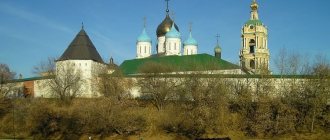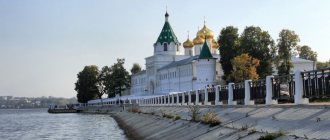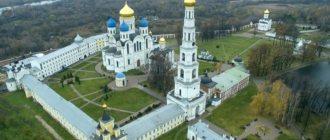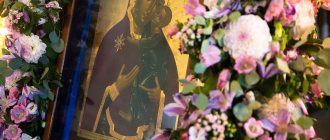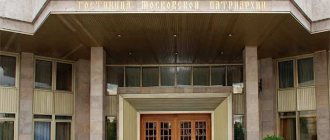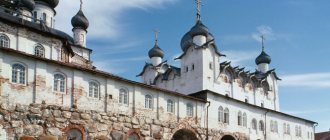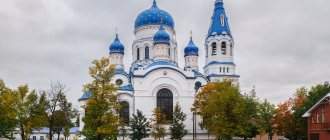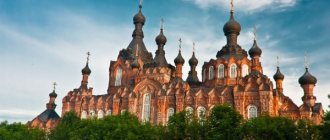Valdai Iversky Bogoroditsky Svyatoozersky Monastery is one of the centers of pilgrimage in the Novgorod region. The Orthodox monastery complex is located in a picturesque location 10 km from the city of Valdai: it is located on Selvitsky Island, almost in the center of the holy Valdai Lake.
Iversky Monastery has an ancient history. Construction began in 1653 on the initiative of Patriarch Nikon of Moscow, and the site was chosen in accordance with the vision that visited him. The first to be completed were the Cathedral Church of the Iveron Icon and the Church of St. Philip of Moscow.
Almost a year later, Nikon visited the monastery under construction, ordered the surrounding Valdai Posad to be renamed Bogoroditskoye Village and consecrated the lake. So the monastery became the Bogoroditsky Svyatoozersky. At the same time, at the initial stage of development, the new monastery acquired the relics of the wonderworker Jacob of Borovichi. The Assumption Cathedral of the monastery was completed in 1656.
In the first half of the 18th century, the Valdai Monastery quickly, and partly forcedly, found itself in stagnation. His property and land went to the St. Petersburg Alexander Nevsky Monastery, which was under construction at that time, to which a large bell was even transported from Valdai, while the monastery was rapidly falling into disrepair. However, already according to the reform of 1764, the Iversky Monastery was assigned to the first class.
© Anna Vasilyeva
Hotels in Valdai near the Iversky Monastery
The history of the monastery in the 20th century includes numerous transformations. In 1919, the complex became the Iverskaya labor artel, but in fact remained a monastic monastery. In 1927, the monks were deprived of the miraculous icon, and the community ceased to exist. In subsequent Soviet years, the island housed a museum (historical, local history), various workshops, a home for the disabled of the Second World War (with accommodation and care), a local school for children with tuberculosis and, finally, a recreation center.
The long-awaited return of the monastery to the Novgorod diocese occurred only in 1991. A large-scale, painstaking restoration of the complex was completed in 2007, then the Assumption Cathedral of the Iveron Monastery in Valdai was consecrated by Patriarch Alexy II of Moscow in honor of the Iveron Icon of the Mother of God, the main shrine of the monastery. V.V. Putin was present at the ceremony. Some work on decorating the monastery continued until 2011.
Currently, the monastery complex includes: the Iveron Cathedral of the Assumption of the Blessed Virgin Mary, the Refectory Church of the Epiphany, the Gate Churches of the Archangel Michael and Metropolitan Philip of Moscow, the Church of Jacob Borovichsky, the chapel with the tomb of the Panayevs, a hipped bell tower, viceroyal and auxiliary buildings, a fence with towers, Nikolaevskaya ( Mikhailovskaya) tower.
At the current monastery there is a museum dedicated to the history of the holy place and Patriarch Nikon. Excursions are available in the monastery complex.
© Vladimir Shefer
History of the temple
The Iversky Monastery in Valdai is the first monastery erected in Rus' after the period of the Great Troubles, by personal order of Patriarch Nikon. He had a miraculous vision of Saint Philip, who gave his blessing to the construction of a monastery in the middle of the lake, which enjoyed a bad reputation among the population.
Later, the patriarch himself consecrated its waters and renamed the lake Holy. The monastery was conceived according to the model of the Athonite architecture of the Greek Iveron Monastery. In the middle of the 17th century, its arrangement began with the construction of the first 2 wooden churches. Construction was carried out using royal donations and government funds.
A little later, stone structures of the Church of the Assumption of the Mother of God and St. Michael's Church were erected, personally consecrated by the patriarch himself.
In addition, the miraculous relics of the revered holy righteous Jacob of Borovichi were transferred here, a copy of the Mother of God icon was brought from Athos, and by royal decree the waters of the Holy Lake with all the islands, many adjacent estates and several Novgorod monasteries were granted for eternal use.
The monastery was inhabited by 70 monks of the Orsha Belarusian monastery with all their property and printing equipment. So the monastery began to print books and develop bookbinding, as well as salt making, wood carving, and the production of tiles and colored mica windows. A school for orphans and several vocational schools were opened at the monastery.
The monastery quickly grew and flourished, attracting a huge number of pilgrims from all over the world. Up to 15 thousand people attended the festive services. Before the beginning of the 18th century, 10 stone buildings were erected on the territory of the monastery.
But after the deposition of Patriarch Nikon, all privileges ceased, the monastery began to lose its significance, and due to a fire in the early 18th century, it lost most of its wealth. After which the monastery was assigned to the new Alexander Nevsky Lavra under construction. But already in the second half of the same century, during the period of Catherine’s reformation, the monastery was classified as 1st class.
In the middle of the 19th century, a cholera epidemic began in the lands of Valdai, which was stopped with the help of a religious procession with a miraculous icon around the city, this returned the former popularity to the monastery and led to its new prosperity.
But with the advent of Soviet power, requisition began, a labor agricultural and logging artel was formed from the monastic brethren, which after 8 years were deregistered for religious propaganda and veneration of the miraculous image, and the community was completely liquidated.
The image of the Mother of God was taken to an unknown direction, and on the territory of the monastery the following were successively formed:
- historical and local history museum;
- labor workshops;
- a military hospital and a nursing home for veterans of the Second World War;
- educational boarding school for children with tuberculosis;
- recreation center Planet.
In the 90s of the last century, the dilapidated buildings were again transferred to the Orthodox Church, which began a comprehensive restoration and restoration of the monastery. Today, the monastery houses a small museum complex dedicated to the history of the creation of the monastery, as well as the life and patriarchal service of Nikon.
Valdai Iversky Monastery
The Valdai Iversky Monastery is famous for the miraculous icon preserved in the Assumption Cathedral, as well as the gilded domes of this Orthodox church. The place for the monastery was chosen by the reformer of Russian Orthodoxy, Patriarch Nikon, when he was Metropolitan of Novgorod. The picturesque Selvitsky Island on Lake Valdai, named St. Nikon, became the site of the construction of one of three monasteries founded by this primate of the Russian Orthodox Church.
The model for the construction of the monastery on Lake Valdai, or the Holy Lake, was the Greek Iversky Monastery on Mount Athos, and its full name sounds like the Valdai Iversky Svyatoozersky Bogoroditsky Monastery. They decided to place it on an island in the center of the lake.
Selvitsky Island in the southern part has an artificial connection with the largest island of the reservoir - Ryabinov, which in a similar way communicates with the mainland shore. On the western shore of the island, a monastery boat dock was built, near which the Holy Gate of the main entrance was located.
The foundation of the monastery took place in 1653, after the approval of the plan by Tsar Alexei Mikhailovich Romanov, who allocated funding from the state treasury. The consecration of the completed stone Assumption Cathedral took place at the end of 1656 personally by Patriarch Nikon.
The less than fifteen years of his patriarchate were full of many innovations - church books and icons were brought into conformity with the Greek canons, bows from the waist and the sign of the cross with three fingers were introduced. All this led to a split among believers and the emergence of Old Believers.
Nikon sought equal participation of the church in governing the state with the tsar, which was decisively rejected by Alexei Mikhailovich, and the patriarch was subjected to disgrace, and then deposition with subsequent exile.
The general view of the Iversky Monastery on the Selvitsky Island of Valdai, or Holy Lake, has been preserved from earlier times. A man-made isthmus with a bridge connects it with the neighboring Ryabinov Island, and that with the mainland.
The remaining buildings of the Valdai Iversky Monastery were built later than the Assumption Cathedral, as was the fortress wall enclosing the monastery, with a total length of more than a kilometer. The contour of the walls almost followed the outlines of Selvitsky Island, separating almost 6 hectares of its territory.
The glacial origin of the reservoir determines the almost complete absence of current, calm water surface and abundance of coastal vegetation.
In the current appearance of the monastery one can see a convenient entrance from the south side, parking for tourist buses and a separate car park for the monastery brethren and clergy. The island's territory is almost devoid of vegetation, except for the western and part of the northern shore. The glacial origin of the reservoir determines the almost complete absence of current, calm water surface and abundance of coastal vegetation.
According to Orthodox canons, the main entrance to the monastery territory is located on the western side. The Holy Gate is made in the form of an arched passage in a two-story building, the upper tier of which is the gateway church of St. Philip. He is famous for his service in the Solovetsky Monastery as abbot, and then for his service as Moscow metropolitan.
Philip protested against the cruel methods of rule of Ivan the Terrible, for which he was removed from office and secretly executed by the tsar's henchman Malyuta Skuratov. Canonized by the Orthodox Church on the eve of the start of construction of the Iversky Monastery, the gate temple was named in his honor.
The central volume of the church is covered with four gable roofs with a spherical vault between them. On the vault there is an octagonal drum and a dome crowning it - a dome with a cross. The left wing is a staircase; the right wing on the first floor is a church shop.
The adjacent one-story buildings house residential monastic cells. Above the entrance arch there is a copy of the icon of the Iveron Mother of God - the Gatekeeper, or Goalkeeper.
It so happened historically that the Valdai Iversky Monastery has two Holy Gates, built in an earlier period and found themselves inside the territory. Between both entrance structures there is a tiled path with lanterns along it.
The second arched entrance is built in a massive rectangular building, on the roof of which is built the Church of the Archangel Michael, the leader (archangel) of the heavenly forces in the fight against the devil. The gate temple has a relatively small square base with an octagonal turret on the roof, on which there is a blank drum with a dome and a cross.
Premises for various purposes are attached to the gate on both sides; the entire building forms a transverse dividing line between the western and eastern parts of the monastery territory.
One of the vitally important buildings on the territory of the monastery was the refectory, built in an ensemble with the Church of the Epiphany immediately next to the Assumption Cathedral. To conduct divine services in winter, a warm church was necessary; Nikon himself ordered it to be provided in the monastery complex.
The building is built on two floors, with utility and storage rooms located below, and a refectory on the second floor. The front porch on the west side consists of a canopied staircase, parallel to the wall and fenced on the outside, with arched openings in the fence. The southern porch is decorated with faceted columns supporting the shelter portal.
Adjacent to the refectory on the eastern side is the Church of the Epiphany - a single-domed temple with a square lower tier and a tower of 8 sides with window openings, a blind drum on a hemispherical roof, and a dome with a cross on top. The decorations around the window openings - stylized kokoshniks and double arches above the windows, like some other elements, are made in red, contrasting with the whiteness of the walls.
The three-tiered tented bell tower of the Valdai Iversky Monastery is combined on a single base with the abbot’s building for the residence of senior clergy. The buildings stretch along the southern monastery wall. The square of the second tier goes into the octagon of the belfry, on the wall of which there is a clock.
Every 15 minutes the bells sound a chime that can be heard throughout the island. The bell tower is crowned with a tent in the shape of a sharp octagonal pyramid with dormer windows (chandeliers) on each side, a blind drum at the top and a dome with a cross.
The rectory has two residential floors and a basement; a distinctive feature of this building is the tiled decoration of the window openings.
The main and oldest building of the Iversky Monastery is the cathedral, first named after the miraculous icon, then renamed the Assumption Cathedral and acquired its original name in the new millennium. A feature of the temple architecture of the Nikon era is a covered gallery on all sides of the building.
The main (western) entrance to the cathedral is designed as a small chapel, the side chapels have two floors and double-sided staircases to enter them. The building, rectangular in plan, consists of three naves, separated internally by supporting columns (pillars).
On the eastern side of the temple it has three altar apses, inside of which there is a three-part altar. Five large domes with gilded domes complete the majestic structure of the Cathedral of the Iveron Icon of the Mother of God. You can get a full impression of the appearance of the cathedral by viewing the slider.
The domes of the Assumption Cathedral of the Valdai Iversky Monastery now shine over a long distance in good weather.
From the time of its construction until 2008, the domes of all five chapters of the Assumption Cathedral were covered with copper sheets, which are characterized by gradual oxidation and acquisition of a dark color. For reasons of increasing the attractiveness of the appearance of the cathedral, the Novgorod diocese decided to cover the domes with gold leaf, which was done during the last restoration of the temple.
Three thousand packs (books) of the thinnest sheets of precious metal, 4 grams each, were used for gilding, that is, 12 kilograms for the entire volume of gilding work.
The richness of the interior decoration of the Cathedral of the Valdai Iversky Monastery, updated during the latest restoration. The massive entrance doors of the Assumption Cathedral are decorated with filigree wood carvings.
The main shrine of the Valdai Iveron Monastery is the miraculous icon of the Iveron Mother of God, which gave it its name. The relic is placed in a prominent place at a height convenient for viewing on the right pillar closest to the iconostasis. At the foot of the pillar there is a separate platform for admirers.
The precious frame of the holy image leaves only the faces and hands of the characters exposed, but they are also quite expressive. The pedestal in front of the location of the image is convenient for those who kiss the icon and kneel in front of it.
The icon located in the island temple is supposedly a copy (an exact copy) made directly in the Iveron Monastery on Mount Athos in Greece. The Greek monastery founded by Georgians, which miraculously found the miraculous icon floating on the waves, allegedly presented the image to the Russian Tsar Alexei Mikhailovich, who transferred it to the Assumption Cathedral.
The origin of the original icon is not known for certain; legend says that it was painted by the Evangelist Luke. One of the apostles who described the life of Christ is indeed known as the first icon painter to depict the Virgin Mary.
The paintings of the walls and columns, as well as the images of the five-tiered altar iconostasis, were more than half lost during the period of persecution of religion and restored in a more modern icon-painting manner. Also, thanks to the skill of the restorers, the richly decorated supporting pillars appear in all their splendor - columns that bear the weight of the upper tier of the building.
The covered gallery surrounding the altar was also used to place images of Orthodox saints with health candlesticks opposite.
One of the attractions of the monastery territory is the ancient oak tree growing here, which is mistakenly considered to have grown from the acorn of the oldest tree on the planet, described in the Bible, but attracts increased attention from tourists visiting the temple. There is a legend that the tree was grown from the acorn of the famous Mamre oak, or Abraham tree.
The sacred oak tree on the banks of the Jordan River is over 5 thousand years old and witnessed Abraham’s meeting with God in the person of the Holy Trinity. The relationship of the Valdai tree with this relic is not possible, because the oldest tree on the planet has not produced acorns for a long time, at least during the period of growth of the oak tree in the monastery (approximately 250 years).
The oak tree on the territory of the Iversky Monastery attracts visitors, among other things, due to the Slavic belief about charging energy from trees. It became a tradition to lean your back against the trunk, supposedly replenishing vitality, including enveloping the oak tree with a whole group of people along the entire circumference of the trunk.
To monks, such rituals seem pagan and intolerant on the territory of the monastery, but it is awkward to prohibit them directly. Therefore, a copy of the miraculous icon was mounted on a tree so that people would kiss it instead of the old custom. However, the ancient tradition of distant ancestors is still alive.
At the end of this short review of the Valdai Iversky Monastery, future visitors are invited to check their own assimilation of the material presented. The published slider contains a number of pictures. They photograph from different directions objects that were covered in previous materials, as well as those that remained without description, including the unmentioned Printing Tower, where Nikon developed local printing. The tall, square structure is crowned with a pyramidal roof of complex configuration, a drum and a spire with a weather vane.
Nothing was said about the towers in the monastery wall, one of which is depicted. It is necessary to determine the location of this structure, relying on the structure of the adjacent walls and using the title image of the review. In the same way, you can identify all other objects of the Valdai Iversky Monastery, no matter from what angle the picture was taken.
This unique quiz arranged for visitors to our site does not serve the purpose of testing school work.
The humorous event is designed to arouse interest in what is being described and encourage a visit and personal inspection. The Valdai Iversky Monastery and its wonderful surroundings are worth it, and the trip will bring indelible impressions. Tags: monasteryRussia
Architect and Exterior Decoration
The main temple of the monastery is built on a hill on the island and is clearly visible from all sides. It is distinguished by monumentality and majesty. The construction of this huge temple was carried out under the personal control of the patriarch and boyar bailiff Artemy Tokmachev, under the leadership of the mason Averky Mokeev, discharged from the Kalyazin monastery, and his assistant carpenter Ivan Belozerov.
The cathedral has huge dimensions for its time, 6.8 m by 21.7 m, raised above the basement, surrounded by a covered gallery on all sides, 3 apses also protrude from the east, 2 tents with 2 floors, designed in the form of a chapel, protrude from the north and south with a small cross each. The building ends with 5 large gilded domes with crosses, which also rise above the porches.
The architect Afanasy Fomin erected 3 monastery buildings in the second half of the 17th century:
- Holy Gates with St. Michael's Church;
- Treasury Corps;
- Nikonovskaya or typographic tower.
In some places you can see preserved ancient decorative tiles decorating window openings. The entrance Holy Gate with the Filippovskaya Church was designed and built by the architect and engineer Savelyev in the 19th century. The door panel is painted with pictures from the lives of the Saints.
Architectural ensemble
The monastery is located on an area of 6 hectares, where there are 30 different buildings, most of which date back to the period of the 17th-18th centuries. The first stone building in the monastery was the majestic Church of the Dormition of the Mother of God, which was considered the largest Orthodox building erected in the 17th century.
The simple, austere 3-nave cathedral is made of white stone, has a square shape in plan, surrounded along the perimeter by a gallery with a porch above the entrances on 3 sides. The temple is crowned with 5 gilded domes with crosses. The powerful walls of the 5-domed temple are cut through by wide windows, 3 on each side. Light pours from the ceiling from the windows of the domes.
Iversky Monastery, Valdai, complex infrastructure.
The warm Church of the Epiphany with a spacious 2-story refectory, bakery and kvass brewery has a strict facade with thin columns, decorated with simple kokoshnik windows. The building has a cubic shape with a 2-tier 6-sided apse, topped with 1 gilded dome.
The entrance to the refectory is decorated with arched vaults, next to it there is a kitchen, and there is a storage room downstairs on the 1st floor. On the 17th-century hipped belfry, located between the rector's and governor's buildings, 13 bells were installed in arched openings.
The Filippovskaya Church was built in the 19th century in the eclectic style in the form of a quadrangle of 2 floors with beveled corners. The building is topped with a dome and has a built-in passage arch below.
The Gateway St. Michael's Church adorns the main entrance to the monastery. The single-domed temple is built over a wide arched opening in the form of a high quadrangle with 1 apse; the sides are decorated with false arched niches that support the overall architectural theme.
Adjacent to it on both sides are the monastic building, the treasury building and the monastery fence with the Nikon or typographic tower, which was one of the first structures. The tower is decorated with a 6-sided tent, topped with a spire with a gilded 1-headed eagle with an orb and a scepter.
Interior decoration
The vaults of the Assumption Cathedral are supported by 6 powerful pillars, the walls are decorated with paintings depicting scenes from the lives of saints and the history of the Athos monastery. Antique oak doors decorated with intricate patterned carvings, as well as forged grilles, have survived to this day in good condition.
The carved 5-tier iconostasis was recreated based on documents and surviving descriptions, and was gilded with red gold. The wooden altar choirs were replaced with stone ones above the central entrance.
The throne on 4 stone pillars is decorated with exquisite silver chasing, and above it there is a carved canopy with gilding. The high place under the canopy is indicated by the image of the seated Savior surrounded by the forthcoming prophet the Forerunner, the Mother of God and the faithful holy apostles.
Shrines and relics
One of the most important and most revered ancient shrines of the monastery is the Iveron Face of the Virgin Mary, a copy of Nikon’s lost icon, made in the mid-19th century as a blessing for militia soldiers before the Crimean War, and miraculously preserved during the years of Soviet hard times in the cemetery Peter and Paul Church of the city of Valdai.
Through the prayers of believers, a huge number of miracles and various healings are performed in front of this image, information about which is recorded by the monks in a special book.
In addition, the monastery has a huge number of Shrines and pieces of relics:
- Tree of the Life-Giving Cross of the Lord;
- Stone from the tomb of the Savior;
- Holy healer and great martyr Panteleimon;
- Apostles Peter, Andrew the First-Called and James, brother of the Lord;
- Great Martyr Anatsasia;
- Reverend Neil Stolbensky;
- Equal to the Apostles Mary Magdalene;
- Holy Metropolitans of Moscow Philaret and Tikhon;
- Reverend Elders of Optina and Kiev-Pechersk.
The holy spring, known as Tekunok, is located near the village of Uzhin. It is very popular not only among visiting pilgrims. But also among the local population, who come to the source to wash themselves before starting an important new business, as well as among newlyweds who pray on their wedding day for a strong family.
During the war, this water helped alleviate the suffering of the wounded in the local hospital. They tried to bury the spring more than once, but every time the water made its way to the surface. Today the source has been cleared, equipped with a font and the Tikhvin Chapel. Water helps heal eye diseases and various inflammations.
Revival of the monastery
The Valdai monastery complex was returned to the Russian Orthodox Church in 1991, and Patriarch Alexy II soon visited it. Abbot Stephen was appointed the first governor, who showed great zeal in restoring the destroyed monastery. Local residents provided all possible assistance, and city enterprises provided financial assistance.
- In 19994, a festival of bell ringers was held within the walls of the monastery, which attracted a large number of bell ringing lovers. The holiday was greeted with great cordiality. In 1995, the brethren rebuilt the cattle yard, which was damaged by fire. In 1996, the monks had the opportunity to reconstruct the interiors of churches, and an iconostasis was installed in the Epiphany Church.
The miraculous Iveron Icon in the Valdai Monastery - In 1997, Archimandrite Ephraim was appointed governor of the complex, who was revered as the wisest inhabitant of the monastery. The saint had colossal experience in spiritual life and knew the art of architecture very well. The archimandrite presented the monastery with an ancient image of the Mother of God “The Sign”, which is still kept in the altar of one of the churches. Saint Ephraim attracted many interested people, which made it possible to speed up the pace of restoration work. Construction did not stop for a day. The first consecration of the throne of the Epiphany Church took place in 1998, the ritual was performed by Archbishop Lev. Soon a heating system was installed in the main cathedral, which made it possible to have year-round services.
Soon the relics of Christian saints were brought to the monastery, and the chapel of the righteous James, located in the city of Valdai, was returned to the complex.
In 2001, the monastery was visited by the President of the Russian Federation V. Putin, who participated in the general divine service. The authorities allocated a large sum of money for the restoration of the bishop's corps.
In 2002, Hieromonk Neil became rector, under whom the reconstruction of the Cathedral of the Assumption began.
Mentors
Over the long and eventful history of the monastery, more than a hundred mentors have changed here, the first of whom was the Novgorod Archimandrite Jacob. The last rector before the closure of the monastery was Archimandrite Joseph, who suffered from a Bolshevik bullet while trying to stop the bloodshed among the civilian population.
After the opening of the monastery at the end of the last century, Bishop Lev was appointed rector, who heads the monastery to this day, but already in the rank of metropolitan.
Soviet period
Before the revolutionary movements, the Valdai monastery was led by Archimandrite Joseph, who was ordained bishop in 1920. Since 1918, the USSR government constantly took away food and livestock from the monastery community. The monks, tired of the oppression, notified the residents of Valdai about this injustice. Soon, residents of nearby settlements rebelled.
The Orthodox people gathered together and seized the weapons depot. The island's guards looked with great trepidation at the approaching crowd of people upset by injustice. The authorities insisted that Abbot Joseph go out to the people and persuade them to disperse; the saint agreed.
- When the boat with the archimandrite approached the shore, they began to shoot at it. The abbot was wounded, he was given ambulance, and the Soviet requisition of the monastery property was urgently canceled. The next morning, martial law was declared in the city, and the army arrived to restore order.
- At the beginning of autumn, the government stormed the monastery complex for the second time. The authorities managed to take away the precious robe with the miraculous face of the Iveron Mother of God, as well as all the ancient objects and jewelry. However, after some time, a decree was issued on the return of the seized utensils.
Iconostasis of the Archangel Gate Church of the Valdai MonasteryThe government would finally plunder the monastery in 1919; the keys to the utility premises would be taken away from the community. At the same time, a Working Committee will be organized on the territory of Valdai Island, which will immediately demand unquestioning submission from the brethren.
- At the end of 1919, the complex was transformed into a labor artel, whose possessions included 200 hectares of pasture land and gardens. In difficult times, the monastery provided all possible assistance to the population in need of food. In 1927, the Valdai Monastery was finally closed, and the Iveron Icon of the Most Pure Mary was confiscated.
During the Soviet period, a local history museum was located on the territory of the monastery. In the 1930s, there were workshops here, during the Second World War - a military hospital, and after - a home for war veterans and disabled people. In the 1970s, a settlement grew on the territory and a recreation center appeared.
Service schedule, operating hours
The Iversky Monastery in Valdai holds regular church services according to the established schedule:
| Weekdays | 7 hours | Brotherly prayer service |
| 7-30 h. | Confession | |
| 8 hours | Divine Liturgy | |
| 9 o'clock | Funeral lithium | |
| 18:00 | Evening service | |
| Saturday, Sunday and holidays | 9 o'clock | Confession |
| 10 o'clock | Divine Liturgy | |
| 11-30 h. | Prayer service before the Iveron Icon | |
| 18:00 | All-night vigil |
The sacrament of baptism is performed on any day of the week at 13:00. The sacrament of wedding is carried out on certain days of the church calendar by prior arrangement from 14:00.
Where to stay in Valdai
As I already said, we stopped at the Eremina Gora recreation center. You will always find reviews about this recreation center on hotel booking sites or aggregator sites, that is, services that collect information about hotels and the cost of living from different booking systems. This usually allows you to choose the most interesting option. In general, we liked Eremina Mountain - a picturesque lake, cozy houses, a bathhouse. In winter, as we understand, there is also something to do there and it is very close to the city itself and nearby interesting places.
Share link:
- Click to share on Twitter (Opens in new window)
- Click here to share content on Facebook. (Opens in a new window)
Article updated:1/03/19
Visiting rules
When visiting an Orthodox monastery, you must follow generally accepted norms:
- Pilgrims and visitors to the monastery must have an appearance appropriate to the place and neat, modest clothing.
- It is not allowed to enter the territory of the monastery in beachwear, shorts and T-shirts, or short skirts.
- When entering a temple, it is customary for women to cover their heads with a scarf, and for men, on the contrary, to bare their heads.
- Before entering the church, it is customary to make the sign of the cross and bow. You must also mute your mobile phone.
- In church, you should not talk or laugh loudly, or distract those praying with questions.
- During the service, it is not customary to move around the temple, light candles or approach the icons.
- You cannot take photographs of monks and pilgrims. Any photo and video filming on the territory of the monastery must be carried out with the permission of the abbot.
- It is necessary to keep the island clean and take care of the surrounding nature.
Patronal holidays
The Iversky Monastery in Valdai celebrates its main holiday on Tuesday, the week following Easter.
In addition, solemn services are held on patronal feast days:
- On February 25 and October 26, the Iveron Icon is celebrated;
- January 19 is the feast of Epiphany or Epiphany;
- On July 16 and January 22 the day of St. Metropolitan Philip is celebrated;
- On August 10, a solemn procession of the cross takes place around the walls of the monastery with the Iveron Icon of the Mother of God;
- August 28 is the day of the Dormition of the Mother of God;
- November 5th is the day of the Venerable Blessed Jacob of Borovichi;
- On November 21, the Cathedral of the Archangel Michael is celebrated.
Archival photographs of the Iversky Valdai Monastery
Photos from humus.livejournal.com
1. Valdai Iversky Monastery. Iveron Icon of the Mother of God. Photo from the 19th century. 2. Valdai Iversky Monastery. Bell tower. Photo 1989 3. Valdai Iversky Monastery. General form. Photo before 1917 4. Valdai Iversky Monastery. Gate Church of Metropolitan Philip 5. Valdai Iversky Monastery. Abbot's corps. Photo 1989 6. Valdai Iversky Monastery. Abbot's corps. Photo 1948 7. Valdai Iversky Monastery. Nikon Tower. Photo from the 19th century. 8. Valdai Iversky Monastery. Cancer of Yakov Borovichsky 9. Valdai Iversky Monastery. Assumption Cathedral. Photo before 1917 10. Valdai Iversky Monastery. Assumption Cathedral. Photo before 1967 11. Valdai Iversky Monastery. Gate Church of Metropolitan Philip. Photo 1970 12. Valdai Iversky Monastery. Gate Church of Metropolitan Philip. Photos before 1967
Interesting facts about the monastery
The Iversky Monastery in Valdai is fraught with many mysterious and inexplicable facts in its history. The lake where the monastery is located has been notorious among the local population since ancient times. They said that unclean spirits in the form of terrible and vile monsters hovered above the surface of the water, and incomprehensible creepy laughter and whistling were heard in the surrounding forest.
This was also confirmed by the craftsmen who arrived to build the monastery. After the consecration of the lake by Patriarch Nikon, at the site of the construction of the monastery, a pillar of fire was visible up to the sky, illuminating all the lands and waters in the area. This phenomenon served as confirmation of the godly construction of the monastery on this site.
For the consecration of the main temple of the monastery, a 1000-pound bell with the image of the patriarch himself was specially cast, and a copper chandelier in the form of a large tree with unusual flowers and strange birds was made abroad.
Since ancient times, the Valdai area has been famous for the production of bells. According to legend, this craft has been going on since the 15th century, when the Novgorod veche bell was broken, and the first bells were cast from its fragments.
Valdai city. Bell Museum
The city of Valdai itself is unlikely to be of obvious interest to tourists. But there is an attraction that is a must-see for almost everyone traveling to Valdai - the Museum of Bells.
The museum is located in two buildings. One (pictured above) is the Church of the Great Martyr Catherine (another name is the Lviv Rotunda), which is an architectural monument. It is interesting that the architectural appearance of the Catherine Church is a bell. Therefore, the establishment of a bell museum in this building is clearly not accidental and is very appropriate. The rotunda project, by the way, was developed by the architect N.A. Lvov, whose works we have already seen in the Tver region - the Znamenskoye-Rayek estate. Without being an expert in architecture, the author's style is quite obvious. This is especially noticeable in the example of the colonnade. The second part of the museum is located a couple of hundred meters away in a red brick building.
At first, I approached the bell museum with some skepticism. Bells are bells. Today, their practical use is reduced to a minimum - churches and temples. However, my skepticism was dispelled by the guide. Entrance to the museum is paid, and the excursion program is paid separately. The opportunity to listen to the story of a local guide is definitely worth taking advantage of, otherwise visiting the museum (especially the first part) risks becoming a boring event and at the same time you will not learn a lot of interesting information about bells and bells and will not understand why this object itself is worthy of a separate museum.
Find out the cost and schedule of excursions to the Museum of Bells
For example, for the first time I learned about the variety of types of bells and bells: church, shepherd's, coachman's, cabinet, door, ship, fire, souvenir, school, wedding...
And they all sound different. In this part of the museum you can try yourself as a bell ringer. The guide also gives the opportunity to listen to the bells, see the ringing technique, bell-ringing techniques, and try to ring the bells for the visitor himself.
Legends connect the beginning of bell production in Valdai with the crash here at the end of the 15th century. veche Novgorod bell. According to legend, the famous coachman’s bells of Valdai were born from its fragments...
...In 1478, by order of Tsar Ivan III, the Novgorod veche bell was removed from the Sofia belfry and sent to Moscow so that it would sound in harmony with all Russian bells and would no longer preach freemen. But the prisoner never reached Moscow. On one of the slopes of the Valdai Mountains, the sleigh on which the bell was being transported rolled down, the frightened horses began to gallop, the bell fell off the cart and, falling into a ravine, was broken into pieces. Countless pieces turned into small bells. Local residents picked them up and began to cast them in their likeness, spreading the glory of the Novgorod freemen throughout the world...
Another belief (and there are many of them) dates the beginning of bell casting in Valdai to the 17th century. In 1656, the sovereign master Alexander Grigoriev cast the Nikon bell in the Iversky Monastery. The master gave the remaining bronze from casting the bell to the Valdashians who helped him. Since then, bells have been ringing in Valdai...
Valdai is the first center for casting coachman bells. The technology for their production is different from the casting of church bells and was developed for the first time in Russia, which makes it possible to call the coachman bell (and primarily the Valdai bell) an exclusively Russian national phenomenon. Valdai bells became so popular over time that workshops from other provinces began to counterfeit them, stamping them with the Valdai stamp. It is also worth noting that a bell was invented in Russia, in which the tongue hits the dome (the most familiar to us). In Europe, sound is achieved by rocking the dome against the tongue. It would seem that the difference is insignificant, but the “Russian” method allows you to create bells of much larger sizes.
On the second territory of the museum the exhibition is more extensive. In addition to the bells themselves, household items are shown here, mainly from the 19th century, one way or another connected with bells. There are interactive games where the visitor is asked to (virtually) harness a horse or cast a bell. You can also watch documentaries about bells.
What struck me most was this accessory:
Back clock. This is essentially the great-grandfather of the modern taximeter - the passenger could always see the travel time on the driver's watch, placed on his back, and thus calculate the cost of the trip.
This is how our only day in Valdai turned out. Probably experts in these places will say that even a week is not enough to appreciate all the beauty of Valdai nature. Still, I’m glad that Valdai and the Iversky Monastery were included in our route. But the time has come to move on - to the Northern capital, and on the way we will visit His Majesty Mr. Veliky Novgorod.
Information for visitors
The monastery is open to visitors every day from 7 am to 9 pm. At the entrance to the monastery there is parking, which is open from 6 am to 10 pm. After this time, outsiders are not allowed to be on the island. There is a pilgrimage center at the monastery, which provides, by prior arrangement, hotel accommodations with meals in the monastery refectory.
The cost of placement is 1 thousand rubles. per day per person.
In the church shop you can not only buy candles and order prayers, but also purchase incredibly tasty fresh bread and monastery pastries, souvenirs and church products. Particular attention should be paid to healing items made from birch bark, which have bactericidal properties. In the church shop you can book a tour of the monastery, which is conducted by the monks of the monastery.
On the 2nd floor you can visit the museum exhibition dedicated to the creator of the monastery and its history, see various household and church objects, vestments and chains, icons, religious artifacts and historical documents.
Excursions to the monastery, prices
You can visit the monastery as part of numerous excursion groups that go to the island daily from different cities:
- A trip from nearby Novgorod, lasting 7 hours, will cost 3 thousand rubles. per person. The program includes travel to the monastery on a comfortable tourist bus, a walking sightseeing tour of the monastery, free time to explore Orthodox shrines, and a visit to the museum’s bell center. All entrance fees are included in the tour price.
- A 1-day excursion program with a group from the northern capital will cost from 1.8 thousand rubles. for a child under 11 years old and 2 thousand rubles. for an adult. In addition to visiting the Iversky Monastery and the Bell Museum, the tour includes a tour of the museum of the provincial town of Valdai. Lunch in the refectory is paid additionally.
How to get there by car
In a personal car you must:
- Follow the Moscow-St. Petersburg highway, marked in the guidebook with the letter M10, and, before reaching the city of Valdai, make a turn towards Borovichi. After 2 km of the road you will need to turn left at the corresponding sign from the road to the monastery islands.
- From the northern capital, you need to take the E105 highway, drive through Valdai without entering the city, turn to Borovichi, and then follow the signs to your destination.
- In winter, there is an ice crossing along the river to the island monastery, which has a very impressive effect on pilgrims with its peaceful landscapes.
How to get there by public transport
The monastery is located 10 km from the city of Valdai, which is very easily accessible by public transport from the bus station on intercity flights from the nearest major cities.
Namely:
- St. Petersburg from the Obvodny Canal Embankment in 6-7 hours;
- Veliky Novgorod in 3 hours;
- or regional buses of the Novgorod region.
Suburban electric trains also run regularly in the direction of Staraya Russa, Edrovo, Bologoe; it is more convenient to go to the Chernushka station, from which the distance to the monastery is about 5 km.
By train from Moscow from the Leningradsky station you should travel along the Pskov direction to the Valdai railway station, and then by bus or taxi over the bridge to your destination. From the northern capital, it is more convenient to travel by train to Uglovka station.
The Valdai Iversky Monastery is not only a generally recognized masterpiece of architecture and the pearl of Svyatoozersk, but also a uniquely beautiful place of northern nature, peace and tranquility, where thousands of visiting travelers and pilgrims find respite from the bustle of the turbulent century, find peace of mind and joy.
How to get to Valdai
420 km. along the new Leningradskoe highway and you are in the city of Valdai. Getting there by public transport is also not that difficult, although there are no direct trains to Valdai from Moscow. You will have to get to Bologoye station first and then to Valdai. The total travel time will be just over 4 hours. This is pure time, and taking into account the transfer... Well, almost a day. Bus. Everything is simpler here, of course. The fastest flight is 5 hours 10 minutes. The price per ticket is less than 1000 rubles per ticket.
Schedule and ticket prices Moscow Valdai
